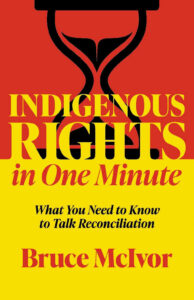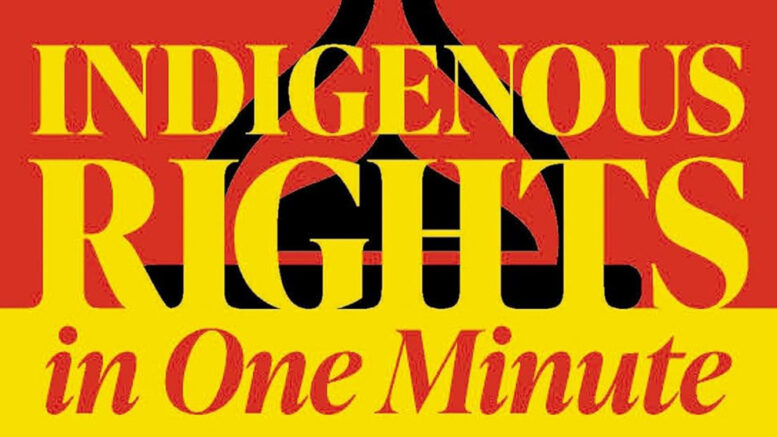by Regan Treewater, Local Journalism Initiative Reporter
(ANNews) – “This book is not intended for lawyers,” begins author Bruce McIvor in his new book Indigenous Rights in One Minute: What You Need to Know to Talk Reconciliation. “It’s meant for non-lawyers interested in Canada’s commitment to reconciliation with Indigenous Peoples, and how to make it a reality” (10).
Dr. Bruce McIvor is uniquely equipped to help demystify the misconceptions or misunderstandings surrounding historical legal structures and policies after a distinguished career as an academic and jurist. He states in his biography posted on the First People’s Law website: “I was focused on working for social justice through an academic career in history until I began working in the law on what I expected to be a temporary basis. My work introduced me to a world of principled, high quality legal advocacy that led me back to university for a law degree and, eventually, to establish First Peoples Law.”
 McIvor is a partner in their Vancouver office and continues to be a strong voice for informative bridgebuilding between communities. His bio elaborates: “First Peoples Law combines my passions for law, history and social justice. Most importantly, it allows me to work with other committed professionals in supporting Indigenous Peoples’ ongoing struggle for respect and justice.”
McIvor is a partner in their Vancouver office and continues to be a strong voice for informative bridgebuilding between communities. His bio elaborates: “First Peoples Law combines my passions for law, history and social justice. Most importantly, it allows me to work with other committed professionals in supporting Indigenous Peoples’ ongoing struggle for respect and justice.”
Sometimes it takes a lawyer to help demystify the intricacies of legal precedent, and that is what McIvor’s 2025 publication seeks to do. “Whether you’re completely new to Indigenous rights, have a basic understanding, want a refresher on key principles or are hoping to win an argument with a friend, family member or co-worker, I hope you find Indigenous Rights in One Minute useful and informative. Most of all, I hope you find it simple and easy to read” (11).
Indeed, universal accessibility informs the structure and organization of the book, and the same conversational tone carries throughout McIvor’s explanation of historical contexts and sensitive discussions of colonial abuse and trauma. In fact, McIvor’s explanations are straightforward enough that extremely raw and painful topics seem intellectually manageable. When unpacking the significance of what ‘Land Back’ refers to, McIvor diplomatically, and concisely provides the core information that a reader would need to then begin further investigations on their own. “The Land Back movement requires Canadians to recognize the fundamental lie at the basis of the Canadian state – the lie that colonizers have simply claimed Indigenous land as their own and relegated Indigenous people to making a claim for their own land. Land Back is also about forging new relationships between Indigenous nations and the Crown that create space for Indigenous people to exercise their inherent rights and responsibilities to make decisions about their lands and benefit from them” (104).
McIvor’s structuring of the book is less of a page-turner, and more of an essential reference tool that every Canadian home should have. Instead of a traditional segmenting of topics into chapters, he has organized material by themes and provides brief explanations for key terms and legal structures using accessible language without embellishment. Literally, each of his entries can be read in close to a minute. “The brief summaries in this book no more than scratch the surface on complicated issues” (205) yet make it possible for readers to better navigate their basic understanding of important, and often intimidating material. This is an innovative strategy for engaging diverse audiences from a spectrum of the demographic pool. The straightforward and almost conversational tone means that newcomers to Canada working on acclimating themselves with the country, and who may be experiencing language obstacles, can access this vital information to gain a more nuanced understanding of the new society they find themselves integrating into. In fact, this might be a great book to provide people before taking their citizenship tests.
Indigenous Rights in One Minute: What You Need to Know to Talk Reconciliation, is an excellent resource for the already socially conscious, and those who may previously have been a bit bashful about their lack of knowledge. It is the sort of essential resource book that will establish itself as a necessity in every Canadian home. Just as the Elements of Style can still be found on any writer’s bookshelf, this is a tool for engagement that should be made use of in daily life to make more informed comments and decisions and better navigate social interactions with sensitivity and compassion. Pick up a copy today, and the next time someone brings up something that is unfamiliar, let McIvor spell out the basics, in just around a minute.



Be the first to comment on "New book offers an easy-to-read primer on Indigenous Rights"